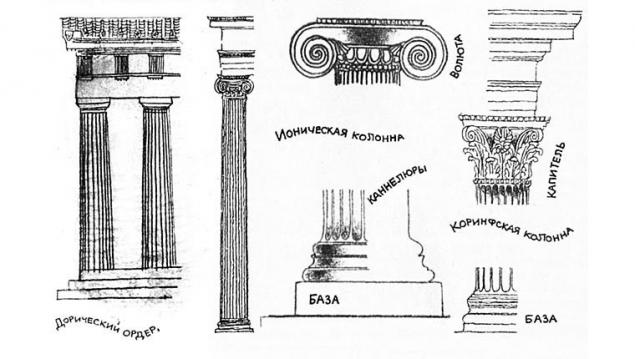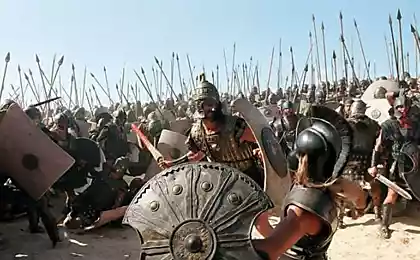1944
Ancient Greece

When we talk about the architecture of ancient Greece, the first thing that comes to mind - it's temples. Majestic, visually light, harmonious, with slender colonnades. It is to the churches increasingly accepted to the concept of "order". The term was first coined by Vitruvius, which we mentioned in the article "Secrets of ancient Greek architects."
Order (from Lat. Ordo - number, order) - a system of carrying and carried elements of the post-and-beam construction with a specific composition, shape and relative position. In ancient Greek architecture are three orders - Ionic, Doric and Corinthian. Since the columns have become one of the most significant elements of the order, and of them we say a few words.
Ancient Greek columns: Doric, Ionic, Corinthian
Doric formed approximately in VII. BC Columns made by the canons of this order have no base, they are more powerful and squat than in other orders. Doric column concise. Flutes, usually not more than 20, pass along the barrel which visually thin column, making it higher. Capital consists of a circular in cross-section and low plate Ehin square plate abaca. Narrow smooth ring, cut the column using a capital, giving it an aesthetic perfection, is a logical transition from vertical to horizontal flutes drawing elements capitals.
Ionic order took shape not long after the end of VII - beginning of VI centuries. BC Ionic column and thinner above. There already is a base complex, consisting of several parts of different geometric shapes. The trunk is cut 24 flutes separated slices. Increasing the number of grooves visually makes the column even more slender and high. Ehin ornamented with two sides decorated with volutes. Moreover, if the central columns volute located diametrically, then at the corner - on the adjacent "Parties" column.
Corinthian originated in the era of the classics - V-IV centuries. BC Corinthian columns taller and slimmer all the others. Although the proportion of slightly modified barrel and base are similar to the Ionic column is. Notable difference from their predecessors became capital. She magnificently decked thread. The basis of the composition comprise two rows of acanthus leaves. A volute Ionic columns are original "transformed" in the unfolding fern shoots and tendrils of the vine.
Interestingly, the "heirs" Ancient Greek architects - the Romans - was considered too rough Doric column, Ionic - too feminine, and therefore rarely used them, preferring the Corinthian order. However, in a later era architects of Europe have been applied to all types. During the Renaissance artists drew inspiration from the Corinthian and Ionic samples style. And the old Doric, found recognition later, in the age of empire. Still later, conciseness, the severity of these columns came to a place in the construction of public buildings and financial institutions. And now Doric column can be seen anywhere in the world.
























